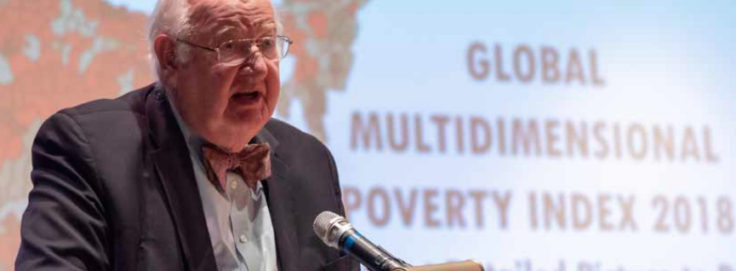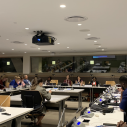
Search
Sir Angus Deaton on the 2018 Global MPI

It’s a great honour and a pleasure to be here today and to help to welcome the new and improved 2018 version of the Multidimensional Poverty Index.
I’d especially like to acknowledge the extraordinary work of my friend Sabina Alkire, who has worked on these indicators from the very beginning and who has had to face not only the intellectual and measurement challenges, which are very considerable, but also over the years has ridden out a good deal of discouragement. She and her collaborators, as well as UNDP, are to be congratulated for this major contribution to global statistics and to global poverty measurement.
We also owe a debt to Amartya Sen, who has insisted for many years that economists were wrong when they measured well-being and poverty with an exclusive focus on income. That seems commonplace now, but it was not commonplace 20 or 30 years ago.
Finally, it is also a bittersweet pleasure to echo what Sabina has just said and to see that the report is dedicated to Sir Tony Atkinson who devoted so much of his life to thinking about poverty and so strongly supported these efforts. I have four brief points that I should like to make today. The first is about what I think of as the correlation issue. This is where multidimensional measures show a key advantage over the alternative – what we might think of as a dashboard of measures: one for living standards, one for education, one for health, and so on. A dashboard looks at each topic one at a time, presenting a summary measure of each: the headcount ratio of income poverty, the infant mortality rate, the fraction of kids who can’t read, and so on. The problem with this approach is that, in the real world, deprivations in different areas are positively correlated with one another. It’s usually the same people who lack resources who also lack education or the sanitation and clean water that protect them against infectious disease. The dashboard of measures entirely misses this sort of clustering. A world in which the people who are sick were neither rich nor poor, or the people who lack education have the same ability to participate in civil affairs, would be, in many respects, a much better world than the one in which we live – and a dashboard cannot tell us which world we are in.
She [Sabina Alkire] and her collaborators, as well as UNDP, are to be congratulated for this major contribution to global statistics and to global poverty measurement.
Of course constructing real multidimensional measures poses an immense challenge of measurement and dashboards are much easier. We cannot get our income data from one place and our health data from another, we have to have data that allow us to look at all the dimensions for each and every person at the same time. Such data are much sparser than the data needed to support a dashboard, and the data are not always ideal in each of the dimensions, but, to me at least, the benefits of being able to handle correlated deprivations are important enough to make the sacrifices worthwhile, and of course we always have the dashboard as a complementary resource.
My second point today is about India and about the extraordinary progress that it has made over the last decade. In 2009, my friend Jean Drèze and I wrote about nutrition and nutritional status in India, and while we were pretty sure that things were getting better for India’s poor, progress was far too slow, and wasting – a measure of the skinniness of children – had actually worsened between the late 1990s and 2005 and 2006.
As late as January 2012, then Prime Minister Manmohan Singh stated the problem of child malnutrition was ‘a national shame’. The amazing progress in the last decade, especially for children, is one of the greatest triumphs of human and economic development. As the report makes clear, there is still a long way to go before multidimensional poverty is eliminated in India, especially for men, women and children in the countryside. But, at least for today, it is worth celebrating the 271 million people who escaped multidimensional poverty in the decade after 2005/06.
For my third point, let me return briefly to methodology. As its critics have pointed out, there is some arbitrariness in the weighting and in the adding together of the fractions who are deprived across different dimensions. Different decisions about these matters will give different answers. They will rank countries differently relative to one another, and they will change the results about who is making more or less progress over time.
The deep problem here of course is that there is no universal way of doing the aggregation. Some people put health before income while others, called economists, often seem to want to put income before everything else. This arbitrariness is sometimes contrasted with the elegant and complete theory that supports the use of poverty measures that use money as their sole metric, but that is a serious mistake.
The standard money metric global poverty counts, useful though they are, are also arbitrary albeit in a different way. I’m particularly thinking of the Achilles’s heel of all money metric poverty measures: which is that they need price indices to convert money amounts, which are relatively easy to measure, into the real purchasing power that we need. This is a problem even within countries, where disputes over price indices have long cast a shadow over poverty measurement, even for the domestic estimates in the United States for example. But it is when we need to convert rupees and yuan and shillings or pesos into common purchasing power measures that we really run into difficulties.
The appropriate price indices here are purchasing power parity exchange rates, or PPPs, and measuring them accurately has been bedeviled not only by technical issues of measuring prices but also by conceptual issues about what it is we are trying to measure in the first place. I am chair of the technical advisory group of the International Comparison Programme (ICP), which produces these price indices, and I am extremely proud of our work and will defend it against anyone. But, and it is a very big but, there is really no way of comparing the real living standards of very poor people in different countries around the world when they buy radically different goods. There really is no way of comparing a poor Bolivian eating quinoa with an Ethiopian eating teff. The ICP ‘solves’ such problems but only by making arbitrary assumptions that are no better or worse than those that are involved in the multidimensional indices. There’s no free lunch.
Finally, let me be a little bit controversial and come to my fourth and final point. On occasions such as this, no matter how much we welcome the new baby and congratulate its parents, it is customary to ask for a little more, and let me do that. To me, one of the greatest advantages of the SDGs over their predecessors, the MDGs, is that the former, unlike the latter, encompass the whole world, not just the poor countries of the world.
Even the World Bank now calculates its $1.90 a day poverty measure for rich countries, including the U.S. And the results have been both controversial and eye opening. In particular, when I used my own poverty line of 4 dollars per person in rich countries, which I believe is pretty much equivalent to 2 dollars a day in poor countries, the World Bank tables show that there are 5.3 million people who were globally poor in the World Bank sense in the United States – 5.3 million people. There are more globally poor people in the U.S. than in Senegal or in Nepal, and the poverty rate in the U.S. is almost identical to the poverty rate in China, in spite of the fact that the U.S. has a GDP per capita that is three and a half times larger. None of this is true for other rich countries in the OECD. America has a serious deep poverty problem.
At the end of last year, at the invitation of the U.S. government, the U.N special rapporteur, Philip Alston, examined the extreme poverty in the U.S. He reported on his findings to the U.N Human Rights Council in June 2018. The report makes for truly dreadful reading, documenting the extraordinary depths of poverty in parts of the U.S.: people sleeping in tent camps on the streets of Los Angeles, people whose yards are washed in untreated sewage because local authorities refuse to supply services, and the widespread use in many towns in America of fines and confiscations, levied on poor people, that many towns and cities are using to finance themselves. The war on poverty has become a war on the poor, which is all a roundabout way of saying that I think it’s a matter of urgency to extend the multilateral poverty work to the United States and to help Americans understand just how badly they are doing by their poorest citizens.
This article was published in Dimensions Magazine 6 (PDF).
















